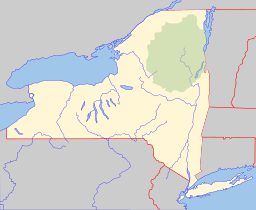Cannonsville Reservoir facts for kids
Quick facts for kids Cannonsville Reservoir |
|
|---|---|

Cannonsville Reservoir at Hancock New York
|
|
| Location | Delaware County, New York |
| Coordinates | 42°06′41″N 75°16′21″W / 42.1113705°N 75.2726253°W, 42°07′50″N 75°17′50″W / 42.1306851°N 75.2973520°W, 42°04′59″N 75°12′30″W / 42.0829358°N 75.2083924°W, 42°04′05″N 75°22′35″W / 42.0680088°N 75.3763070°W |
| Type | Reservoir |
| Primary inflows | West Branch Delaware River |
| Primary outflows | West Branch Delaware River, West Delaware Tunnel |
| Catchment area | 455 sq mi (1,180 km2) |
| Basin countries | United States |
| Water volume | 362,000,000 m3 (0.087 cu mi) |
| Surface elevation | 1,148 feet (350 m) |
The Cannonsville Reservoir is a huge lake in Delaware County, New York. It's not a natural lake, but a reservoir built by people to hold water. This reservoir is a very important part of the New York City water supply system, helping to provide drinking water for millions of people in New York City. It's located in the western part of the Delaware Watershed and was finished in 1964, making it one of the newest reservoirs that New York City owns.
To create the reservoir, the town of Cannonsville was moved or covered. The reservoir now sits within the towns of Tompkins and Deposit.
Contents
Cannonsville Reservoir: A Giant Water Bottle for NYC
The Cannonsville Reservoir was created by building the Cannonsville Dam on its western side. This dam holds back more than half of the water from the West Branch Delaware River. The reservoir is the furthest west of all the reservoirs that supply New York City.
It started providing water in 1964. Its drainage basin, which is the area of land where all the rain and snowmelt flow into the reservoir, is the largest of all New York City's reservoirs. This basin covers about 455 square miles (1,178 square kilometers).
How Water Travels to New York City
The Cannonsville Reservoir can hold a massive amount of water, about 95.7 billion US gallons (362 million cubic meters). Water from the reservoir flows into a long underground tunnel called the West Delaware Tunnel. This tunnel is about 44 miles (71 kilometers) long and starts in Tompkins, New York.
The water then travels through this tunnel to the Rondout Reservoir. From there, it joins the Delaware Aqueduct, which is about 85 miles (137 kilometers) long. This aqueduct is super important because it provides about 50% of New York City's drinking water!
The Long Journey of Drinking Water
The Delaware Aqueduct continues its journey, even crossing beneath the Hudson River. It then reaches other reservoirs closer to New York City. These include the West Branch Reservoir in Putnam County, New York and the Kensico Reservoir in Westchester County, New York.
Finally, the water travels further south to the Hillview Reservoir in Yonkers. Here, the water from the Delaware Aqueduct mixes with water from other aqueducts, like the Catskill Aqueduct and the New Croton Aqueduct. This combined water is then sent through a huge tunnel system to homes and businesses all over New York City.
Engineers are also thinking about using the Cannonsville Dam to create electricity. They are looking into building a power station there that could generate 14.08 megawatts of hydroelectric power.
Rivers and Streams That Feed It
Many smaller rivers and streams flow into the Cannonsville Reservoir, bringing fresh water. These are called tributaries. Some of them include:
- Johnny Brook
- Dry Brook
- Sherruck Brook
- Trout Creek
- Loomis Brook
- Chamberlain Brook
- Dryden Brook
- Maxwell Brook
- Fish Brook
Images for kids






